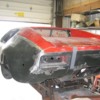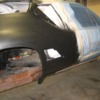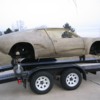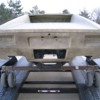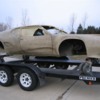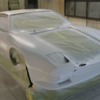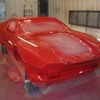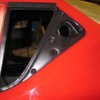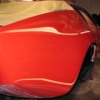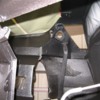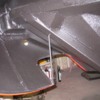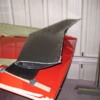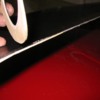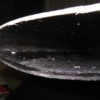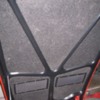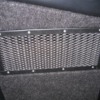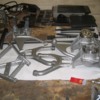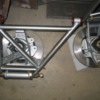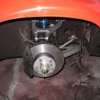Left side view with all of the panels in position. The quarter and taillight panel still needed some straitening but the deck gap fit was correct and ready to be detailed.
Kirk – that's pure automotive sculpture, you are indeed a sheet metal artist – well rescued, it shows what can be done, if you have the talent! 
Your an Artist Kirk
Absolutely incredible ! What talent and skill ! Thanks for documenting and sharing Kirk.
OK...gotta jump on the band wagon. 
Very impressive resurrection Kirk! Really fantastic metal work...!
BTW....don't think for a minute the process steps are boring. They eye candy is great, but the steps/details are the critical process to get there.
Very impressive resurrection Kirk! Really fantastic metal work...!
BTW....don't think for a minute the process steps are boring. They eye candy is great, but the steps/details are the critical process to get there.
quote:Thought I would post a shot of the finished car just before the transport picked it up. The rebuild shots can be a bit boring but critical to proving the car was rebuilt with the proper care and detail.
I agree with Rob.
I am one of those that LOVES to see ALL of the build pictures.
Very impreeive job Kirk.
I am one of those that LOVES to see ALL of the build pictures.
Very impreeive job Kirk.
Speechless, as I would have thought that car was a goner!!
I'm sure I'm like most people on the board when I say I didn't know you could do this Kirk!!! It's great to see what is possible when it really looked like the car was gone. Bravo indeed!!!!
Mark
Mark
It really came out fantastic. It is somewhat comforting to know that all things are not necessarily lost.
Personally though from previous experience I am always concerned about the new longevity of the sheetmetal on cars like this.
I personally have seen very short life cycles on the sheetmetal that has been heated, shrunk and pounded out?
That metal doesn't seem to have great longevity once put back into service?
I noticed the primer that was mentioned and it definitely will be on my list for next time. Sure hope it does the trick?
Thank you for the photographic journey. I really enjoyed it a lot.
Personally though from previous experience I am always concerned about the new longevity of the sheetmetal on cars like this.
I personally have seen very short life cycles on the sheetmetal that has been heated, shrunk and pounded out?
That metal doesn't seem to have great longevity once put back into service?
I noticed the primer that was mentioned and it definitely will be on my list for next time. Sure hope it does the trick?
Thank you for the photographic journey. I really enjoyed it a lot.
Thank you all for the kind words and support.
Working bent sheet metal properly takes patients and a light hand with the hammer. Also if you are shrinking with what I call "big heat" or a torch, that will suck the life right out of the tin. I use a shrink disk which heats the top surface on the sheet metal to pull it back. It's a slow process. Second when you are growing a low area or dent, the metal grows to the hammer so you start dolling around the outside of the low spot and hammer O-SO-LIGHTLY working you way into the center. This takes time and often a re-shrink using the disk. If you follow this method, the metal will be fine and have a long the happy new life cycle until the next crash.
Here is a view of the shell being moved to my paint booth area. It's in Rust Defender polyester primer and is ready to be blocked. I layer the car with 2 colors of material so you can clearly see the surface changes during blocking. Sometimes I use tint to change the layer colors and sometimes I use an actual color change---beige to gray---so on. This was a layer color change. Polyester is much harder to sand than urethane primer but it will not shrink in time and holds the top coat polish from shrinking much better---from what I have seen over many years of painting.
I painted my first full vehicle in high school---1974---it was a van in lacquer with multy-colored custom paint including my first attempt at mural painting---a vision to some---nightmare to others.
quote:Originally posted by PanteraDoug:
I personally have seen very short life cycles on the sheetmetal that has been heated, shrunk and pounded out?
That metal doesn't seem to have great longevity once put back into service?
I noticed the primer that was mentioned and it definitely will be on my list for next time. Sure hope it does the trick?

Working bent sheet metal properly takes patients and a light hand with the hammer. Also if you are shrinking with what I call "big heat" or a torch, that will suck the life right out of the tin. I use a shrink disk which heats the top surface on the sheet metal to pull it back. It's a slow process. Second when you are growing a low area or dent, the metal grows to the hammer so you start dolling around the outside of the low spot and hammer O-SO-LIGHTLY working you way into the center. This takes time and often a re-shrink using the disk. If you follow this method, the metal will be fine and have a long the happy new life cycle until the next crash.
Here is a view of the shell being moved to my paint booth area. It's in Rust Defender polyester primer and is ready to be blocked. I layer the car with 2 colors of material so you can clearly see the surface changes during blocking. Sometimes I use tint to change the layer colors and sometimes I use an actual color change---beige to gray---so on. This was a layer color change. Polyester is much harder to sand than urethane primer but it will not shrink in time and holds the top coat polish from shrinking much better---from what I have seen over many years of painting.
I painted my first full vehicle in high school---1974---it was a van in lacquer with multy-colored custom paint including my first attempt at mural painting---a vision to some---nightmare to others.
Attachments
Another view shows our modular caster wheel system. All of the cross bars slip into sleeves that lock down using simple 3/8 nuts welded to the sleeves and bolts tightened onto the crass bar. The caster lock on the same way I have many sizes of casters---some for a rough surface (pictured), smooth caster for the floor, and large wheel/tire combo for the rear if you need to move the entire frame fixture to another location.
The body has also been guide coated which is the darker shades you see on the top beige color primer.
The body has also been guide coated which is the darker shades you see on the top beige color primer.
Attachments
Kirk,
Pure artistic genius. Before and after photos alone always raise questions as to how a car was fixed, but your details of the steps involved demonstrate a true passion for perfection.
Julian
Pure artistic genius. Before and after photos alone always raise questions as to how a car was fixed, but your details of the steps involved demonstrate a true passion for perfection.
Julian
WOW. Great to know what can be done and who can do it.
You Kirk can do it. Well done and thanks for the insight.
You Kirk can do it. Well done and thanks for the insight.
Great job Kirk! Every time you show us photos of your work the attention to detail always stands out! Thanks for sharing and please keep posting photos!
Thank you all once again for your kind words. There are many very talented hobbyist and professionals on the forum and I'm happy to among such a great group.
Next shot is the car blocked. I start with 180 dry---re-guide coat with 500% thinned color and wet block with 320---re-guide coat and finish wet sand with 500. The 180/240 dry block cut the surface straight but you have to be very careful on the next 2 steps making sure all of the dry sanded surface get re-sanded with the finer paper or your color will print scratches.
I have spent a lot of time in the booth---way back in my very early days the local dealerships would bring me their hard to match metallics for color blending---helped pay for my first Pantera.
Next shot is the car blocked. I start with 180 dry---re-guide coat with 500% thinned color and wet block with 320---re-guide coat and finish wet sand with 500. The 180/240 dry block cut the surface straight but you have to be very careful on the next 2 steps making sure all of the dry sanded surface get re-sanded with the finer paper or your color will print scratches.
I have spent a lot of time in the booth---way back in my very early days the local dealerships would bring me their hard to match metallics for color blending---helped pay for my first Pantera.
Attachments
Just a mostly hidden detail after the finish sanding and buffing was completed. We step sand the clear starting with 500 to 600, moving on to 1200 and finishing with 2000. If some of the coarser scratches get missed, the area is re-sanded with 2500 during the final buff---lots of work.
Attachments
Next step was to re-finish the undercarriage with paintable undercoat and black semi black epoxy. This view show a bit of the passenger rebuild and the inside of the repaired left quarter panel in the gas-tank area. I was a chore to blend the textures that remained on the car into the smother new fabricated wheel well materials in an effort to make them match and not appear to have been re-done. I often had to make the undercoat rougher than the equipment would spray the material by using a dabber brush for applying wall paper glue---what a mess but it worked quite well. Kida like antiquing the underside---happens naturally with age but that's another issue.
Attachments
Here is a detail we do on all of the Pantera's quarter panels. The rod in the picture stabilizes the lower panel at the exhaust opening and helps protect the taillight panel corners from cracking do to vibration---a simple but effective fix.
Attachments
Fantastic work and dedication to quality Kirk.
As the southern evangelist might say, "brothers and sisters I feel your pain".
I had quite a misplaced youth myself. I worked hard on as much stuff as I could missing virtually ALL of the sex, drugs and rock & roll of the times. Now I know too much and no one will give me work because they think I deserve to work only for top dollar! That makes me unimployable now.
Maybe the Devil is right? Anyone know a hot looking drunken rock n'roll slut? This is too much work for me for bottom dollar?
I sure appreciate your work and sharing the pictures.
Now I know I can send the car to you when they bring it to me and want it fixed and it looks impossible to do at any price.
As the southern evangelist might say, "brothers and sisters I feel your pain".
I had quite a misplaced youth myself. I worked hard on as much stuff as I could missing virtually ALL of the sex, drugs and rock & roll of the times. Now I know too much and no one will give me work because they think I deserve to work only for top dollar! That makes me unimployable now.
Maybe the Devil is right? Anyone know a hot looking drunken rock n'roll slut? This is too much work for me for bottom dollar?
I sure appreciate your work and sharing the pictures.
Now I know I can send the car to you when they bring it to me and want it fixed and it looks impossible to do at any price.
Posted my thank you to Wayne on the wrong header---sorry for pulling his old thread up. I am showing my lack of computer suaveness along side the obvious poor typing and proof reading skills after reading some of my own posting. I'll try proofing a bit closer.
The wing project was interesting. The original wing was so poorly constructed and already had multiple repairs that were poorly done, I decided to build him a new one.
This is an exact replica of the original shape including the trailing edge which is always much thicker on every alternative wing available. The AmeriSport replica is much lighter than the original unit, uses composite end caps that are the correct shape and thickness, and is manufactured in one piece rather than bonded dry which add weight and make the wing much weaker. The picture shows the freshly mounted center section less end caps.
The wing project was interesting. The original wing was so poorly constructed and already had multiple repairs that were poorly done, I decided to build him a new one.
This is an exact replica of the original shape including the trailing edge which is always much thicker on every alternative wing available. The AmeriSport replica is much lighter than the original unit, uses composite end caps that are the correct shape and thickness, and is manufactured in one piece rather than bonded dry which add weight and make the wing much weaker. The picture shows the freshly mounted center section less end caps.
Attachments
Here's a shot of the un-finished trailing edge with 1/8 tape on it and in the hand. The edge was actually thinner that the tape and matched the folded aluminum original exact. It was difficult to find a way to produce an edge this thin with the necessary strength needed to hold up but we found a solution.
Attachments
Quit showing off, would you?

Just kidding - keep the pictures coming.. This is very amazing stuff, and an encouragement to everyone.
Rocky
Just kidding - keep the pictures coming.. This is very amazing stuff, and an encouragement to everyone.
Rocky
How do you rust proof inside of the channels that you had to make and weld into place? Shouldn't those have been pre-coated with something? Maybe galvanized?
Bloody hell! Amazing work Kirk. I Love the fixture too. Thanks for sharing, I know it takes ages sorting through all the pictures and adding words but it's always worth it.
Johnny
Johnny
quote:Originally posted by PanteraDoug:
How do you rust proof inside of the channels that you had to make and weld into place? Shouldn't those have been pre-coated with something? Maybe galvanized?
Most of the pre-made fitted parts that were plug welded were first internally coated. When we do a full body reconstruction car, I have them E-coated when possible. Besides these option, I've made several different internal spray tips on flex hoses that spray 360 degrees. Also all of the seams are sealed from the outside before undercoating, painting, or texturing. If you looked at the wheel-well leg rebuild shots, you can see the pre-coated internal areas and box sections are removed, the car is positioned up-side-down to spray inside the opened cavities if the access is large enough. I have used galvanized in the past but the zinc make the welds difficult unless your running very precise spot-welding equipment. Hope this helps enplane the protection questions. I do not have pictures of the process but next time we internally seal, I'll get some shots to show everyone. Thanks for the questions---they help with getting better info for all to utilize if a similar situation come up on other cars under restoration.
quote:Originally posted by Johnny Woods:
Bloody hell! Amazing work Kirk. I Love the fixture too. Thanks for sharing, I know it takes ages sorting through all the pictures and adding words but it's always worth it.
Johnny
Thanks Johnny---miss you my friend---we need to get together. What are you working on now? To dam bad we are not closer---I would dearly love to build something with you. Please
stay in touch---let's talk this Spring.
Moving on the customer decided to have the suspension freshened up so we did the gray Imron finish and replaced or re-plated all of the hardware. Here's a shot of some finished suspension parts before assembly.
Attachments
Add Reply
Sign In To Reply


